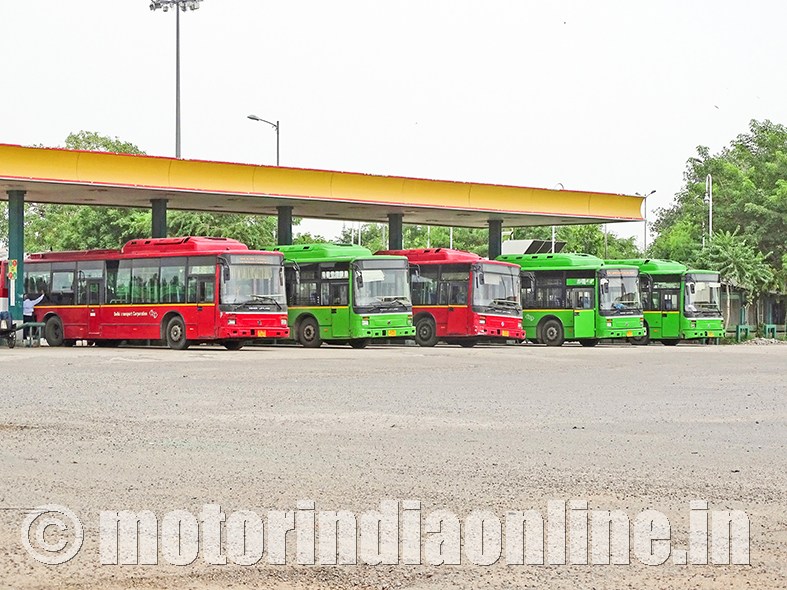Fleet operators are perhaps backbone of bus transportation in the country. This section briefly analyses the performance of State Transport Undertakings (STUs) that offer bus-based public transportation for the masses across the country. The latter part of the section incorporates the views and responses of three leading STUs in the country on sustainable bus transportation, along with that of Shuttl – the technology-informed, seat-based bus aggregator.
Out of 1.97 million buses registered in the country (2015), the share of public sector bus operators is just around 7 percent, roughly 140,000 buses. Yet, the state-owned transport corporations can be proudly called as true ‘mass transport’ service providers in the country – merely because of the wide spectrum of people they serve – from low-rung poor and marginalized, middle classes, to the elites and tourists. Embracing the principle of welfare and samaritan service, they are the sole transporters of people who can’t afford private mobility, have disabilities, and those living in totally excluded remote areas. Thus, any talks on sustainability mobility for masses in India can hardly afford to exclude them.
The statistics are worth considering. The report titled “Review of Performance of State Road Transport Undertakings in 2015-16” released by Ministry of Road Transport and Highway (MoRTH) in last October brought out various data on the operational efficiency of STUs. STUs have performed around 1.48 billion passenger-kms per day and carried more than 68 million passengers per day (both city and intercity). Indian railways carries around 23 million passengers per day, thus STUs carries 3 times more passengers per day.
For 47 out of 54 STUs in the country, the average fleet utilisation stands at 90.4 percent in 2015-16. The average age of the fleet of the reporting STUs ranged from 3.17 years to 12.85 years the same period. The staff to bus ratio was at 5.17, higher compared to international standards. The average occupancy ratio of 69.65 per cent points to the dire need to improve occupancy government buses to generate more revenue.
In terms of revenue, ticket sales constitute about 85 percent, while non-traffic revenue was just around 4 percent. On the cost side, staff payments, fuel and lubricant costs accounted for around 70 percent of the total cost. Further, both interest and taxes taken together formed about 14 percent of the total cost incurred by STU buses. Thus, if the government waive off interest and taxes alone, it can help STUs to achieve better financial health.
Although profit making is not a good parameter to evaluate the performance of public bus systems as they are serving larger social and welfare causes, STUs must engineer innovation in the areas of operational costs and value-addition in services. There is need for larger investment in enterprise resource planning, planning and scheduling, depot management system, maintenance and workshop system and modern maintenance infrastructure. Government, on the other hand, should consider public funding to STUs not as economy-distorting subsidies, but as effective public investments that can translate into economic and social development of masses through sustainable mobility.
With regard to private players, who constitute around 85-90 percent of intercity bus operations in the country, the vehicle utilization stands between 93-95 percent. The vehicle productivity (kms-per-day for every bus) stands higher for large operators at 450 kms, while small operators could achieve only 280 kms on an average. However, the latter score higher occupancy rate of 95 percent, which declines considerable for medium and large operators to 85 and 70 percent respectively. Improvements in quality of services and ERP can push up the performance of private bus players to a great extent.
(With inputs from ‘Review of the Performance of State Road Transport Undertakings for April, 2015 – March, 2016’ and Bus Operators Confederation of India (BOCI))
The Importance of Bus Shelters
Bus shelters are very common in India. In those days, there used to be a pillar with a ‘bus stop’ sign board on it, but bus shelters these days in metros and cities are sophisticatedly made with fibre glass, steel or other fancy materials, with colourful advertisements and lighting. But we see how well they are maintained, almost every bus shelter in the country remains dilapidated and fallen into partial ruins. It is not uncommon to see those commuters waiting for buses usually standing outside or aside those shelters. We also know why.
A good bus shelter is an absolute necessity for any successful urban transit system. Some of those shelters in cities like Delhi, Mumbai, and Bengaluru now contain real-time information (RTI) displays that shows estimated time of arrivals and scheduled time of buses. In reality though, the failure rate of the systems seems exceptionally higher. People deem these as useless and give up, reiterating the perception that the city buses will never turn up on time and may turn up unannounced. They aren’t totally wrong in their assumptions either.
Properly maintained shelters with RTI systems can be a great asset in persuading people to use buses and use them more often. RTI networks cannot be expected to be absolutely fool-proof, but since a network is already in place, bus operators must try to recalibrate and update them to deliver the best they can. Providing some basic amenities in these shelters like lighting, fans, Wi-Fi, mobile charging points, and so on can be the next step to make commuters stay with bus transportation. But, first and foremost, we need more shelter structures and they must be kept in good shape!
